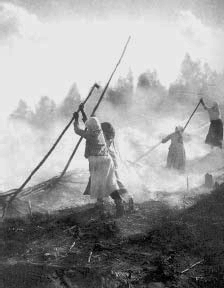Agricultural Burns and Global Warming
Agricultural burning serves several purposes. First, it quickly clears land of plant residues, a task that otherwise would require a large investment in labor, equipment, fuel, and time. Second, it returns some of the mineral nutrients in the biomass back to the soil. Finally, burning produces high temperatures that sterilize the top soil layers to reduce pest problems for subsequent crops.
The downside of agricultural burning is that most of the organic nutrients in the biomass literally go up in smoke rather than enrich the soil. This burning dissipates all of the nitrogen, some of it as N2O (nitrous oxide), and all of the organic carbon, either as CO2 (carbon dioxide), CO (carbon monoxide), or CH4 (methane) depending on oxygen availability. Together, these greenhouse gas emissions amount to roughly 12% of the world’s total from human activities (U.S. Environmental Protection Agency 2006a). Lost into thin air are 25% of the phosphorus, 20% of the potassium, and 5% to 60% of the sulfur in the biomass. [1] Soot and smoke particles from burning adversely affect air quality throughout agricultural regions. Lastly, burning reduces the albedo of the land surface (i.e., amount of sunlight reflected) for several weeks [2] and thereby enhances the amount of solar radiation absorbed by about 5%. Alternatives to agricultural burning include physically removing plant residues and using them for feed, bedding, or biofuels; chopping residues and mechanically incorporating them into soils; controlling pests through crop rotations, time of planting, and chemicals; and leaving fields fallow and letting natural decomposition occur. Usually, farmers employ a mix of these alternatives. Many local governments restrict burning to times when the fire danger is low and weather conditions readily disperse the soot and smoke that burning releases.
[1] Fairhurst, T. H., C. Witt, R. J. Buresh, and A. Dobermannand, eds. (2007) Rice: A Practical Guide to Nutrient Management, 2nd Edition. International Plant Nutrition Institute&International Potash Institute, Singapore, http://www.ipni.net/ppiweb/seasia.nsf/$webindex/C76C1813872632A9482570760008A05F.
[2] Beringer, J., L. B. Hutley, N. J. Tapper, A. Coutts, A. Kerley, and A. P. O'Grady (2003) Fire impacts on surface heat, moisture and carbon fluxes from a tropical savanna in northern Australia. International Journal of Wildland Fire 12:333-340.
This is an excerpt from the book Global Climate Change: Convergence of Disciplines by Dr. Arnold J. Bloom and taken from UCVerse of the University of California.
©2010 Sinauer Associates and UC Regents
